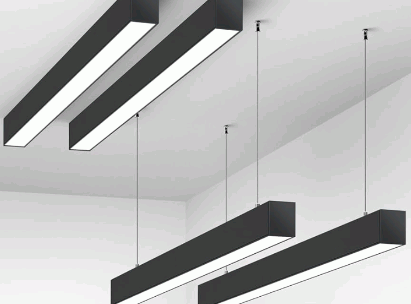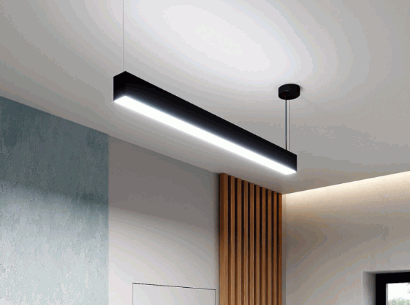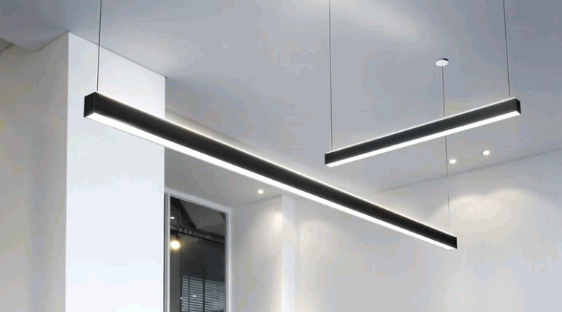LED linear lighting is a versatile and energy-efficient lighting solution that is gaining popularity in various spaces.
We will explore the definition and description of LED linear lighting, the different types available, how it works, and the numerous benefits it offers.
Discover the applications of LED linear lighting in commercial, residential, and outdoor spaces, as well as the factors to consider when choosing and installing this lighting option.
We will debunk common myths and misconceptions surrounding LED linear lighting and uncover its many advantages.

What Is LED Linear Lighting?
LED Linear Lighting refers to modern lighting technology that utilizes LED fixtures in linear forms to provide efficient and aesthetically pleasing illumination in various spaces such as offices, service stations, elevators, and more.
One of the primary advantages of LED Linear Lighting is its energy efficiency, as LEDs consume significantly less power compared to traditional lighting sources, leading to reduced electricity bills and lower carbon footprint. LED linear fixtures offer uniform light distribution across spaces, minimizing glare and enhancing visual comfort for occupants. These lighting solutions are highly durable and have a longer lifespan, reducing maintenance costs and contributing to sustainability efforts in commercial and residential settings.
Learn more: Is LED Lighting Sustainable
Definition And Description
LED Linear Lighting is a versatile lighting solution that combines the benefits of LED technology with linear fixtures, offering unique and sleek lighting options for various spaces.
LED Linear Lighting refers to a type of illumination that utilizes LED technology in elongated fixtures, providing a continuous strip of light. These fixtures are composed of a series of connected LED modules arranged in a linear fashion, allowing for uniform and seamless lighting distribution. The design of LED linear lights is often characterized by their slim profile and flexibility, enabling them to be installed in various settings such as offices, retail stores, architectural spaces, and residential interiors.

Types Of LED Linear Lighting
LED Linear Lighting comes in various types such as LED iBond, Plane lights, and tubes, offering flexibility in design, high-quality illumination, and customizable color temperature options.
LED iBond linear lighting systems are known for their innovative design that integrates light, power, and communication in a single streamlined fixture. These luminaires offer exceptional flexibility and efficiency, making them ideal for architectural lighting applications.
- Plane lights are sleek, modern luminaires that provide uniform and glare-free illumination. They are popular for their versatility and can be customized to suit different design aesthetics and lighting requirements.
- Tube lights, on the other hand, are traditional linear lighting solutions that deliver reliable performance and energy efficiency. They are easy to install and maintain, making them suitable for a wide range of commercial and residential settings.
How Does LED Linear Lighting Work?
LED Linear Lighting operates by using LED technology to convert electrical energy into light energy, providing efficient and effective illumination in a linear format for various indoor and outdoor spaces.
LED fixtures in linear lighting systems work on the principle of converting electrical energy directly into light through the process of electroluminescence. When electricity passes through the semiconductor material in the LED, it excites the electrons, causing them to release photons, which in turn emit light.
LED technology offers numerous advantages over traditional lighting sources in linear lighting applications. LEDs are highly energy-efficient, have a long lifespan, produce minimal heat emission, and are environmentally friendly due to their low energy consumption and absence of harmful chemicals like mercury.

Benefits Of LED Linear Lighting
LED Linear Lighting offers numerous benefits, including energy efficiency, long lifespan, flexible design options, and cost savings in terms of reduced energy consumption and maintenance.
LED Linear Lighting’s energy efficiency is one of its standout features, as it consumes significantly less power compared to traditional lighting sources.
The long lifespan of LED linear lights ensures durability and reduced replacement costs, making them a cost-effective lighting solution in the long run.
The design flexibility of LED linear lighting allows for various customization options to suit different spaces, leading to enhanced aesthetic appeal and ambiance.
Along with these advantages, the reduced energy consumption of LED linear lights contributes to overall energy savings, making them environmentally friendly while also improving performance and reducing operation costs.
Energy Efficiency
One of the key advantages of LED Linear Lighting is its exceptional energy efficiency, as LED fixtures consume less power while delivering high-quality illumination, making them an environmentally friendly lighting choice.
LED technology is known for its ability to reduce power consumption significantly, leading to energy savings for both residential and commercial spaces. By using LED linear lights, individuals and businesses can enjoy reduced electricity bills while maintaining optimal lighting levels. These lights have a much longer lifespan compared to traditional lighting sources, further emphasizing their cost-effectiveness.
The eco-friendly aspects of LED linear lights extend to their impact on reducing carbon footprint. LED technology produces less heat, minimizing energy waste and contributing to a greener environment. Unlike incandescent or fluorescent lights, LEDs do not contain hazardous materials like mercury, making them safer to use and dispose of.
Longevity
LED Linear Lighting fixtures are known for their long lifespan, lasting significantly longer than traditional lighting sources like fluorescent tubes, thereby reducing replacement and maintenance costs over time.
The durability of LED linear lights is often attributed to their solid-state construction, which makes them resistant to vibrations and frequent switching, thus minimizing the chances of premature failure. This robust design not only ensures a prolonged operational life but also reduces the need for frequent replacements, leading to substantial savings in both time and money.
Design Flexibility
LED Linear Lighting provides unmatched design flexibility, allowing for sleek, minimalistic installations in various settings such as suspended, surface-mounted, or recessed lighting configurations.
LED Linear Lighting is known for its ability to adapt to diverse environments effortlessly, enhancing interior spaces with a touch of modern sophistication. With their slender form factor and customizable lengths, LED fixtures can transform a room’s ambiance and create visually striking effects. Whether it’s illuminating a hallway with a soft glow or highlighting architectural features in a commercial space, LED linear lights offer endless possibilities for designers and architects to play with light and shadow dynamics.
Cost Savings
LED Linear Lighting offers significant cost savings through reduced energy consumption and lower maintenance requirements, making it a cost-effective lighting solution for commercial and residential applications.
LED Linear Lighting is known for its efficiency in converting electricity into visible light, which results in less wasted energy in the form of heat compared to traditional lighting options. This efficiency not only reduces electricity bills but also minimizes the need for frequent bulb replacements, leading to lower maintenance costs over time. The durability of LED lights means they have a longer lifespan, further contributing to the long-term economic benefits for businesses and homeowners alike. The cost efficiency of LED Linear Lighting extends beyond just the initial investment, making it a wise choice for those looking to save on lighting expenses.

Applications Of LED Linear Lighting
LED Linear Lighting finds diverse applications in commercial spaces such as offices, service stations, and elevators, where its unique blend of efficiency and aesthetics enhances the lighting ambiance.
LED linear lights are extensively used in office environments to create a well-lit workspace that boosts productivity and reduces eye strain among employees, creating a conducive atmosphere for focused work.
In service stations, the bright and uniform illumination provided by LED linear lighting ensures safety and visibility for customers and staff alike, enhancing the overall customer experience.
In elevators, the sleek design of LED linear lights adds a touch of modern elegance, transforming the often overlooked space into a well-lit and welcoming environment.

Commercial Spaces
LED Linear Lighting is widely used in commercial spaces for its energy efficiency and modern aesthetic, making it a popular choice for illuminating offices, retail stores, and warehouses.
LED linear lights have revolutionized the way commercial spaces are illuminated, providing a sleek and contemporary lighting solution that enhances productivity and ambiance. The uniform and consistent light output of LED linear fixtures ensures optimal visibility, reducing eye strain and creating a pleasant working environment.
The energy efficiency of LED technology significantly lowers electricity costs, making it a cost-effective lighting solution for businesses. Along with saving on utility bills, LED linear lighting fixtures have a longer lifespan and require minimal maintenance, further reducing operational expenses.

Residential Spaces
In residential spaces, LED Linear Lighting offers a blend of functionality and style, providing homeowners with energy-efficient and aesthetically pleasing lighting solutions for indoor and outdoor settings.
LED Linear Lighting fixtures are ideal for creating ambient lighting in living rooms, kitchens, bedrooms, and outdoor spaces such as patios and gardens. The versatility of LED linear lights allows for customizable designs, enabling homeowners to accentuate architectural features, highlight artwork, or illuminate pathways effectively.
With their slim profiles and sleek designs, LED linear lights seamlessly integrate into various areas of a home, contributing to a modern and minimalist aesthetic. The dimmable capabilities of these fixtures further enhance the ambiance and mood of any room, providing residents with control over brightness levels and lighting intensity.

Outdoor Spaces
LED Linear Lighting is ideal for outdoor spaces such as gardens, pathways, and facades, where its weather-resistant and high-performance features make it a reliable choice for enhancing outdoor lighting aesthetics.
One of the key benefits of utilizing LED Linear Lighting in outdoor settings is its ability to withstand various weather conditions, ensuring durability and longevity without compromising on performance. These lights are designed to resist moisture, corrosion, and dust, making them perfect for outdoor environments exposed to the elements.
LED linear lights offer exceptional energy efficiency, consuming significantly less power compared to traditional lighting options, resulting in lower electricity bills and reduced environmental impact. By enhancing visibility and brightness, they not only improve safety in outdoor areas but also create a visually appealing ambiance. Their sleek design and flexibility allow for creative lighting solutions that can accentuate architectural features or highlight landscaping elements.

Factors To Consider When Choosing LED Linear Lighting
When selecting LED Linear Lighting, factors such as color temperature, beam angle, dimming capabilities, and installation requirements play a crucial role in determining the effectiveness and suitability of the lighting solution for specific spaces.
Color temperature is a vital consideration as it affects the ambiance and mood of the environment; warmer tones create a cozy feel, while cooler hues are more invigorating.
The beam angle determines the spread of light, essential for task lighting or accentuating architectural features.
Dimming options provide flexibility in adjusting light levels to meet varying needs, enhancing comfort and energy efficiency.
Installation needs, including surface-mount or suspended options, impact the aesthetics and functionality of the space.
Color Temperature
Color temperature is a critical factor to consider when selecting LED Linear Lighting, as it determines the warmth or coolness of the light emitted, impacting the ambiance and visual appeal of the illuminated space.
Warm color temperatures, such as 2700K-3000K, create a cozy and inviting atmosphere, making them perfect for residential settings like living rooms or bedrooms.
On the other hand, cooler temperatures, around 4000K-5000K, are ideal for task-oriented spaces like offices or kitchens, providing bright and energizing lighting.
When choosing LED Linear Lighting for commercial areas such as retail stores or galleries, a color temperature of 3500K-4000K is often preferred to enhance product visibility and attract customers with a balanced and natural-looking light.
Selecting the right color temperature ensures that the lighting design complements the intended mood and functionality of the space.
Beam Angle
The beam angle of LED Linear Lighting fixtures determines the light distribution and coverage area, affecting the visibility and focus of the illumination in specific spaces.
A beam angle plays a crucial role in how light is dispersed from these linear fixtures. Depending on the angle, the light can be concentrated in a narrow beam or spread out over a wider area. This characteristic is vital in achieving the desired lighting effects, ensuring that spaces are adequately illuminated based on their requirements.

Dimming Options
Dimming options in LED Linear Lighting allow users to adjust the light intensity as needed, providing flexibility and control over the lighting ambiance in various spaces.
The ability to control the brightness of the LEDs can significantly impact the overall atmosphere of a room or an outdoor setting. Dimmable LED linear lights are not just energy-efficient but also enhance the aesthetic appeal of a space. By adjusting the light output, a user can set the perfect ambiance for different activities or moods, whether it’s creating a cozy setting for a movie night or brightening up a workspace for increased productivity. The dimming feature also allows for customization, letting users tailor the lighting to their preference at any given time.

Installation Requirements
Understanding the installation requirements of LED Linear Lighting is essential to ensure proper placement, wiring, and mounting for optimal performance and safety in different indoor and outdoor environments.
In terms of placing LED linear lights, consider the lighting needs of the space; whether it is task lighting in a kitchen, accent lighting in a living room, or ambient lighting in an outdoor patio. This will guide you in determining the appropriate distance between fixtures for even illumination.
Proper wiring is crucial to avoid voltage drop and ensure a consistent light output. Plan the wiring layout carefully, following manufacturer instructions and safety guidelines to prevent potential hazards.
Mounting LED linear lights securely is key to their longevity. Be aware of weight restrictions and surface compatibility. Use suitable mounting hardware to ensure a stable and durable installation.
How To Install LED Linear Lighting?
Installing LED Linear Lighting involves following specific steps to ensure proper placement, wiring, and configuration of linear fixtures for optimal illumination in indoor and outdoor spaces.
Initial placement of the LED linear fixtures is crucial for achieving the desired lighting effect. Start by measuring the installation area and marking the positions where the fixtures will be mounted.
Securely attach the fixtures using appropriate mounting brackets or clips, ensuring they are level and evenly spaced to create a uniform lighting pattern.
When wiring the fixtures, connect them according to the manufacturer’s instructions, making sure to use the correct voltage and polarity to prevent any issues.
Common Myths And Misconceptions About LED Linear Lighting
There are common myths and misconceptions surrounding LED Linear Lighting, such as concerns about color quality, installation complexity, and upfront costs, which can be debunked through factual information and understanding of LED technology.
One prevalent myth about LED linear lights is regarding their color quality; some believe that LEDs emit harsh and unnatural light. However, LED technology has advanced significantly, providing a wide range of color temperatures and high color rendering capabilities, making them ideal for various applications.
Conclusion
LED Linear Lighting emerges as a cutting-edge lighting solution that offers energy efficiency, design flexibility, and enhanced aesthetics for various indoor and outdoor applications, making it a preferred choice for modern lighting needs.
The versatility of LED linear lights makes them suitable for commercial spaces, residential areas, and even architectural lighting designs. These fixtures can be seamlessly integrated into ceilings, walls, or floors, providing a sleek and modern look to any environment. LED linear lighting is known for its long lifespan, reducing maintenance costs and carbon footprint. With customizable color temperatures and dimming options, LED linear lights can create the perfect ambiance for different settings, from offices to retail outlets.

